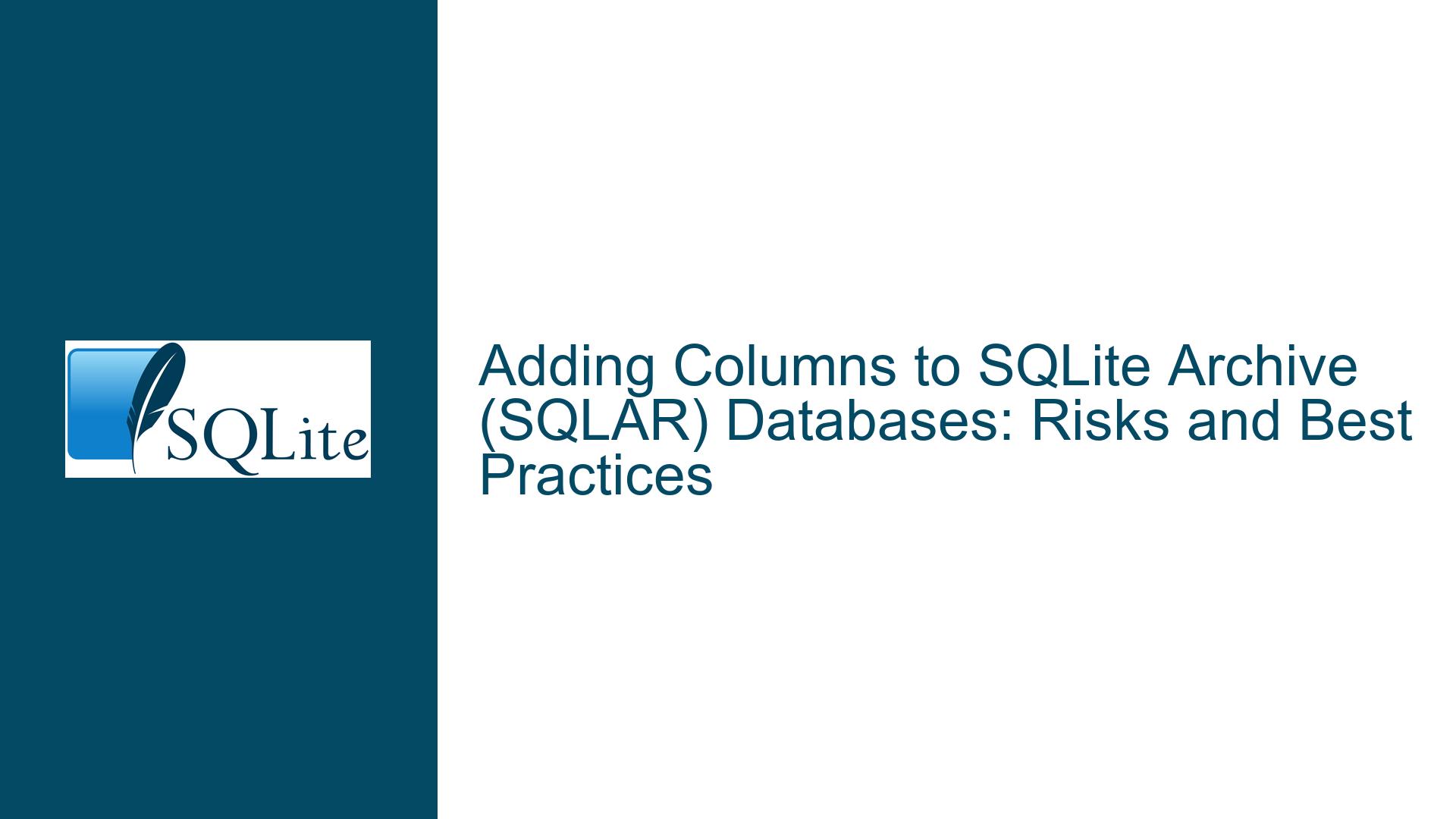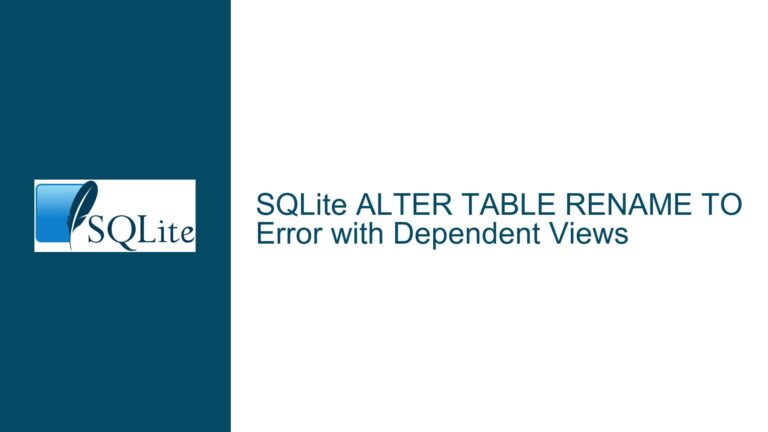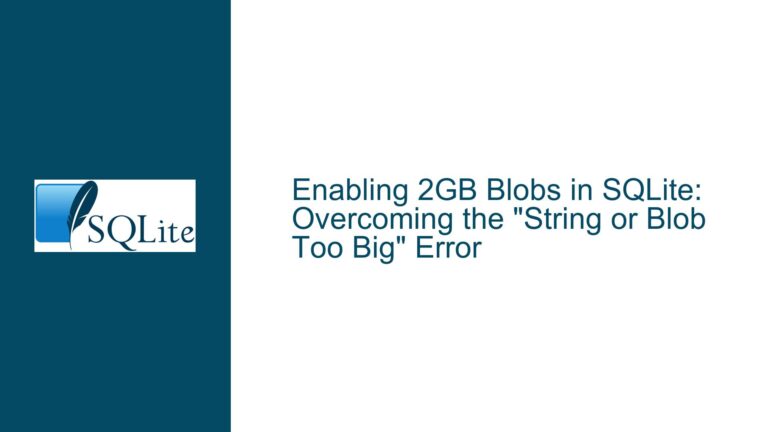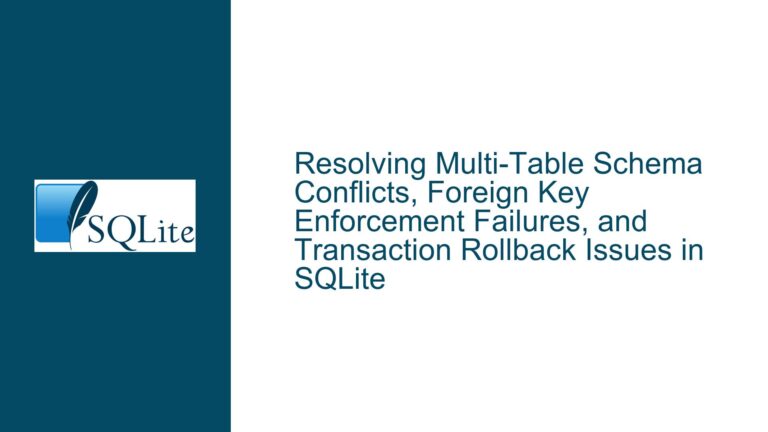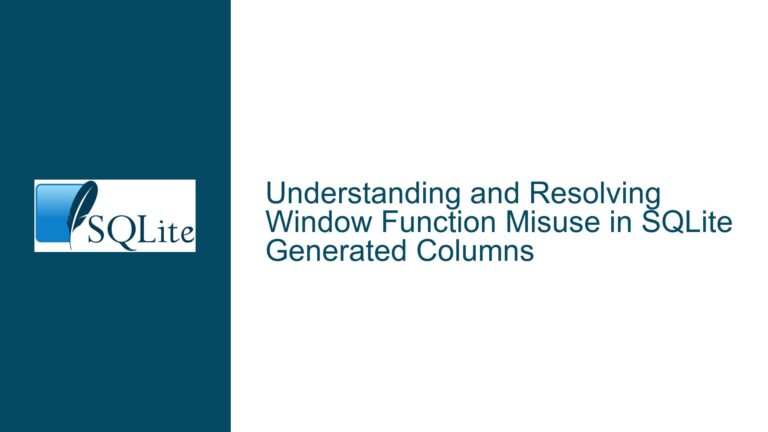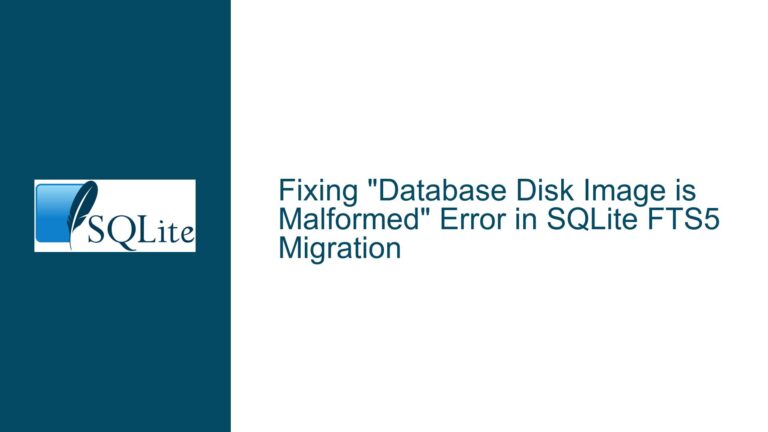Adding Columns to SQLite Archive (SQLAR) Databases: Risks and Best Practices
Adding Custom Columns to SQLite Archive (SQLAR) Tables
SQLite Archive (SQLAR) is a specialized use case of SQLite designed for storing and managing file archives, often used in applications like Fossil SCM. The SQLAR schema typically includes a table named sqlar with predefined columns such as name, mode, mtime, sz, and data. These columns store metadata and the compressed content of archived files. However, users may find it necessary to extend this schema by adding custom columns, such as creation_date, last_access_date, or description, to accommodate additional metadata specific to their use case.
The process of adding columns to an existing SQLAR table is straightforward using the ALTER TABLE command. For example, to add a creation_date column, one could execute:
ALTER TABLE sqlar ADD COLUMN creation_date TEXT;
While this operation is syntactically valid and works in most scenarios, it raises questions about long-term compatibility, performance implications, and potential risks. Adding columns to a table that is integral to a system like SQLAR requires careful consideration of how the schema changes might interact with future updates to the SQLite library or the SQLAR implementation.
The primary concern is whether such modifications are "future-safe." In other words, will the addition of custom columns to the sqlar table remain compatible with future versions of SQLite or SQLAR? While there are no explicit guarantees, the current behavior suggests that such modifications are unlikely to cause issues. However, this is not a blanket endorsement, as unforeseen changes in the SQLite library or SQLAR implementation could theoretically introduce incompatibilities.
Risks of Schema Modifications in SQLAR Databases
Adding custom columns to the sqlar table introduces several potential risks that must be carefully evaluated. These risks stem from the interplay between the SQLite library, the SQLAR implementation, and the specific use case of the database.
One significant risk is the possibility of schema conflicts in future updates. The SQLAR format is not a static specification; it may evolve over time to include new features or optimizations. If a future version of SQLAR introduces a new column with the same name as a custom column added by a user, it could lead to conflicts or unexpected behavior. For example, if a user adds a description column and a future SQLAR version also adds a description column with a different data type or purpose, the resulting schema could become ambiguous or invalid.
Another risk is performance degradation. The sqlar table is often heavily utilized in applications that rely on SQLAR, such as version control systems. Adding unnecessary columns can increase the size of each row, leading to higher storage requirements and slower query performance. This is particularly relevant for large archives with thousands or millions of files. Additionally, indexes on the sqlar table may need to be rebuilt or extended to accommodate the new columns, further impacting performance.
Data integrity is also a concern. Custom columns may introduce new constraints or triggers to enforce business rules, such as ensuring that creation_date is always earlier than last_access_date. While these constraints can improve data quality, they also add complexity to the database schema. If not carefully implemented, they could lead to inconsistencies or errors during data insertion or updates.
Finally, there is the risk of breaking existing tools or scripts that rely on the standard SQLAR schema. Many applications and utilities expect the sqlar table to have a specific set of columns. Adding custom columns could cause these tools to malfunction or produce incorrect results. For example, a backup script that assumes the sqlar table has only the standard columns might fail when encountering a custom column.
Best Practices for Extending SQLAR Schemas
To mitigate the risks associated with adding custom columns to the sqlar table, it is essential to follow a set of best practices. These practices are designed to ensure compatibility, maintain performance, and preserve data integrity while allowing for the necessary schema extensions.
First, always prefix custom column names with a unique identifier to avoid conflicts with future SQLAR updates. For example, instead of adding a column named description, use a prefix such as user_description or app_description. This reduces the likelihood of naming collisions and makes it clear that the column is user-defined.
Second, carefully evaluate the necessity of each custom column. Avoid adding columns that are not strictly required for the application’s functionality. For example, if the creation_date and last_access_date columns are only used for informational purposes and not for querying or sorting, consider storing this metadata in a separate table or external file instead of adding it to the sqlar table.
Third, document all schema modifications thoroughly. Maintain a record of the custom columns added to the sqlar table, including their names, data types, and purposes. This documentation should be stored alongside the database schema and shared with all stakeholders. It will serve as a reference for future maintenance and help prevent accidental modifications or conflicts.
Fourth, test schema changes extensively before deploying them to production. Create a copy of the SQLAR database and apply the modifications in a controlled environment. Verify that all existing tools, scripts, and applications continue to function correctly with the modified schema. Pay particular attention to performance metrics, such as query execution times and storage usage, to ensure that the changes do not introduce unacceptable overhead.
Fifth, consider using a separate table for custom metadata instead of modifying the sqlar table directly. For example, create a new table named sqlar_metadata with a foreign key relationship to the sqlar table. This approach isolates custom data from the standard SQLAR schema, reducing the risk of conflicts and making it easier to manage schema changes. Here is an example of how this could be implemented:
CREATE TABLE sqlar_metadata (
id INTEGER PRIMARY KEY,
sqlar_id INTEGER REFERENCES sqlar(rowid),
creation_date TEXT,
last_access_date TEXT,
description TEXT
);
This approach has several advantages. It keeps the sqlar table lean and focused on its primary purpose, improving performance and reducing the risk of conflicts. It also provides greater flexibility for managing custom metadata, as the sqlar_metadata table can be modified or extended without affecting the core SQLAR schema.
Sixth, implement robust error handling and validation for custom columns. Use SQLite’s constraint and trigger mechanisms to enforce data integrity rules. For example, to ensure that creation_date is always earlier than last_access_date, you could define a trigger like this:
CREATE TRIGGER validate_dates BEFORE INSERT ON sqlar_metadata
FOR EACH ROW
WHEN NEW.creation_date >= NEW.last_access_date
BEGIN
SELECT RAISE(ABORT, 'creation_date must be earlier than last_access_date');
END;
Finally, stay informed about updates to the SQLite library and the SQLAR implementation. Monitor release notes and community discussions for any changes that might affect custom schema extensions. If a future update introduces a new column that conflicts with a custom column, be prepared to rename or remove the custom column to maintain compatibility.
By following these best practices, you can extend the SQLAR schema to meet your application’s needs while minimizing the risks of incompatibility, performance degradation, and data integrity issues. While there are no absolute guarantees of future safety, a disciplined and thoughtful approach to schema modification will help ensure that your SQLAR databases remain robust and maintainable over the long term.
